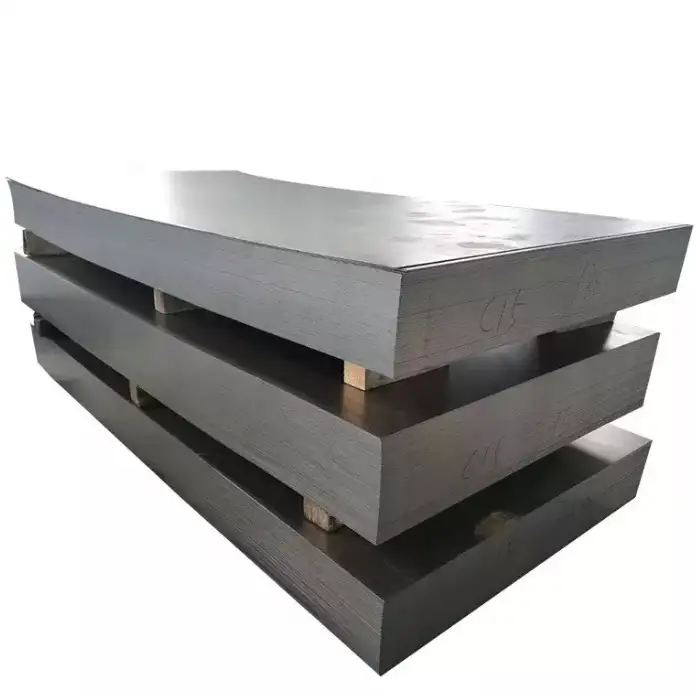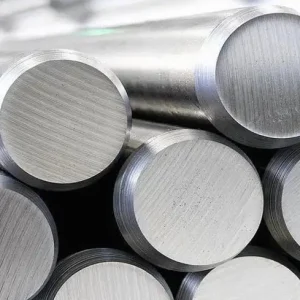1095 high-carbon steel plate (AISI/SAE 1095, UNS G10950, EN 1.1274) is a classic, low-alloy carbon plate engineered for maximum hardness and edge/wear performance after heat treatment; it is widely used for knives, wear parts, springs and cutting tools where hardness and edge retention are primary requirements and corrosion resistance is secondary. When properly heat-treated (oil quench + temper), 1095 achieves very high hardness (often in the mid-to-high HRC range) and excellent abrasive wear resistance, but it sacrifices some toughness and corrosion resistance compared with lower-carbon steels.
What is 1095 high-carbon steel plate?
1095 is a plain carbon steel in the SAE/AISI 10-series family. The “95” denotes nominal carbon ~0.95% (high-carbon). It is designed for cold-worked and heat-treated components where high surface hardness and edge retention are required. Typical product forms used by fabricators include hot-rolled plates, cold-rolled and tempered strips, bar stock and sheet/plate cut to size. Important identifiers: AISI/SAE 1095, UNS G10950, and EN/DIN roughly 1.1274 (C100S/Ck100 family).
Chemical composition
The table below is a commonly referenced composition window for commercial 1095 material. Individual suppliers may publish narrow chemistries for specialty batches; always request the mill certificate for your lot.
| Element | Typical % (range) |
|---|---|
| Carbon (C) | 0.90 – 1.03. (core characteristic) — high carbon content gives hardness potential. |
| Manganese (Mn) | 0.30 – 0.60 |
| Phosphorus (P) | ≤ 0.04 |
| Sulfur (S) | ≤ 0.05 |
| Silicon (Si) | ~0.15 – 0.35 (trace depending on producer) |
| Iron (Fe) | Balance (~98.3–98.8%) |
Note: Some EN/DIN trade names (C100S, 1.1274) present slightly different Mn/Si windows but the high carbon signature (~1.0%) is the same.
Mechanical & physical properties
Properties depend heavily on processing (normalized, oil-quenched, tempered). Below are representative values for typical plate/strip in annealed and quenched/tempered conditions.
Annealed / normalized (approx.)
-
Density: 7.85 g/cm³.
-
Tensile strength (Rm): 500–900 MPa (depends on heat treatment).
-
Yield strength (Rp0.2): ~350–600 MPa.
-
Elongation: 8–18% (annealed higher, quenched lower).
-
Brinell / HRC (annealed): low-to-mid HB range.
Quenched (oil) & tempered (typical target ranges for blade & spring applications)
-
Quench/temper targets: 50–62 HRC (depending on temper temp) — many blade makers aim 55–60 HRC; springs often tempered to lower hardness for toughness.
Practical note: Hardness tightness and toughness are controlled by quench media, section thickness and temper sequence. MatWeb and ASM datasheets provide variant-specific property tables for normalized, oil-quenched and tempered deliveries.
Specifications, equivalents & standards
-
AISI / SAE: 1095 (also referenced as C1095 in some tables).
-
UNS: G10950.
-
EN / DIN equivalents: EN number often given as 1.1274 (C100S / Ck100 family) or similar depending on the cold-rolled spring steel naming conventions.
-
Typical ordering specs: ASTM/ASME references may be used for mechanical testing; for spring strip there are EN 10132-4 and EN 10271 usage contexts for oils and tempers. Always request mill test report (MTR) to verify chemistry and heat treatment.
Sizes, thicknesses and weight examples
1095 is supplied as plates, strips and cut pieces. Plate thickness ranges commonly: 0.5 mm up to 25+ mm, with most knife and tool applications using 1–6 mm plate and spring components using thinner strip.
Weight calculation (engineering formula):
Weight (kg) = Length (m) × Width (m) × Thickness (m) × Density (7,850 kg/m³)
Example table — approximate weights for a 1.0 m × 2.0 m plate
| Thickness (mm) | Volume (m³) | Weight (kg) |
|---|---|---|
| 1.0 | 0.002 | 15.7 kg |
| 3.0 | 0.006 | 47.1 kg |
| 6.0 | 0.012 | 94.2 kg |
| 10.0 | 0.020 | 157.0 kg |
(Use density 7,850 kg/m³; this is the standard approach used by fabricators for logistical and cost estimates.)
Manufacturing forms, finishes & heat-treatment states
-
Forms: Hot-rolled plate, cold-rolled strip, hardened & tempered strips, ground flat stock, billets and bar.
-
Surface finishes: mill-scale (hot-rolled), cold-rolled bright, ground, milled or strip-ground for blade stock.
-
Heat treatment: Typical hardening uses oil quench from 800–900 °C followed by tempering (temper temp controls final HRC); annealing cycles used for forming before final quench. Failure to control processing yields brittleness or cracking in thicker sections.
Typical applications
1095 is chosen where high hardness and edge retention matter:
-
Knife blades (commercial & craft bladesmithing), machetes, utility cutters.
-
Wear parts: scraper blades, discs, mower knives, harrow teeth.
-
Springs and high-stress flat springs (thin tempered strips), clock parts, reed valves in some EN/DIN applications.
Design note: For parts that require corrosion resistance or high impact toughness, consider alloy or stainless alternatives. 1095 should be supplied with appropriate corrosion protection if used outdoors.
Which is better, 1045 or 1095 carbon steel?
-
Carbon: 1045 ≈ 0.45% C, 1095 ≈ 0.95% C. Carbon content drives hardenability, edge retention and wear resistance.
-
Toughness: 1045 is tougher and more forgiving (lower carbon), better for parts that must absorb shock.
-
Hardness & edge retention: 1095 can be hardened to higher HRC — better edge retention for blades — but is more brittle.
-
Weldability & formability: 1045 is easier to weld and form than 1095 (1095 requires special pre/post-heating protocols).
Engineering choice: Use 1095 where edge/wear is priority; use 1045 where balanced strength and ductility are required.
Advantages and limitations
Advantages
-
High achievable hardness and wear resistance.
-
Cost-effective compared with many alloy steels.
-
Widely available in multiple product forms (plate, strip, bar).
Limitations
-
Limited corrosion resistance — requires coatings or maintenance for outdoor use.
-
Lower toughness vs lower-carbon steels — risk of chipping in thin, brittle sections.
-
Heat-treatment sensitive — requires careful quench control (oil quench recommended for many sections).
2025 Price comparison — USA, Europe, China
Methodology & caveats: plate prices vary by thickness, width, surface finish, heat-treatment, order quantity, and delivery terms. Below are representative price ranges (USD) in 2025 based on public supplier listings (retail and B2B platforms) and market indices. These numbers are indicative — for precise quoting, request a formal offer with quantity, delivery INCOTERM and required QC.
Sources used for price signals: Alibaba supplier listings (China/export), OnlineMetals & AlphaKnife (US retail/knife-stock pricing), European distributors (Metallstore24 / Tomtek / EU retailers) and general HRC market indexes. See citations after the table.
| Region | Typical supply type | Representative price (USD/kg) | Notes & typical MOQ |
|---|---|---|---|
| China (export / factory FOB) | Bulk plate (tonne lots) | ~$0.40 – $0.80 / kg (≈ $400 – $800 / MT) | Alibaba B2B listings show offers across this band depending on thickness & MOQ; factory pricing often at lower end for large orders. |
| USA (retail / small cut pieces) | Cut-to-size knife/flat stock | ~$5.50 – $15.00 / kg (retail sheet/bar) | Online retailers (small sheets/pieces) show substantially higher per-kg prices due to small sizes and cutting costs. Bulk industrial buyers pay lower unit prices. |
| Europe (distributors / small batches) | Blade stock, ground strip | ~€3.00 – €10.00 / kg (USD ≈ $3.2 – $11 / kg) | EU vendors selling 1.1274/1.1274 blade/strip often charge mid-range retail prices; larger domestic coil orders push price down. |
Interpretation:
-
If you are sourcing tons for manufacturing, China factory FOB pricing is generally the most competitive.
-
If you need small, precision ground or pre-hardened strips or blade stock, US/EU specialty suppliers sell at a higher per-kg price because of processing and inventory costs.
-
Macro steel indices (hot-rolled coil) influence base metal cost; specialty grades add processing premiums.
Quality control & recommended inspection tests
For procurement of 1095 plate, require from the mill/supplier:
-
Mill Test Report (MTR) showing actual chemistry, heat treatment condition and mechanical test results.
-
Hardness profile (if pre-hardened product ordered) — especially through-thickness HRC variation for thicker plates.
-
Ultrasonic or ultrasonic+Eddy current checks for internal defects for critical components.
-
Flatness & dimensional tolerance report, NDT if required for safety parts.
-
Certifications: ISO 9001 supplier audit evidence, and compliance to any contractual standards (EN, DIN, ASTM if applicable).
Why choose MWAlloys
MWAlloys is an established supplier and fabricator offering 1095 high-carbon steel plate and strip from our Chinese production lines. We supply OEM and aftermarket industrial lots with:
-
100% factory direct pricing (no trading markup on factory lots) — competitive FOB Shanghai / Ningbo.
-
Stock & fast delivery for common thicknesses (1–6 mm strip / 1–12 mm plate) — typical lead times for stocked sizes: 2–10 working days depending on quantity and finish.
-
Custom services: precision cutting, cold rolling and tempering, ground flat stock for blade manufacture, and supply of MTRs and hardness records.
-
Quality controls: incoming inspection, dimensional checks and full documentation to support international procurement needs.
FAQs
-
Is 1095 stainless?
No, 1095 is a plain carbon steel with little to no chromium and will rust unless protected. -
Can 1095 be welded?
It can be welded but requires pre-heat (≈260–315°C) and post-heat to avoid cracking; many fabricators avoid welding final heat-treated parts. -
What hardness can 1095 reach?
With proper oil quench and temper, 1095 can reach ~55–62 HRC depending on section thickness and temper cycle. -
Is 1095 good for knives?
Yes, it is a traditional blade steel for high edge retention; however it needs maintenance to prevent corrosion. -
What is an EN/DIN equivalent?
Common equivalents are EN 1.1274 (C100S family) / DIN Ck100 types — confirm exact spec with the supplier. -
How to calculate plate weight?
Weight (kg) = L (m) × W (m) × t (m) × 7850 (kg/m³). -
Is 1095 suitable for springs?
Yes. 1095 (and C100S) are used for high-stress flat springs and certain coiled springs when correctly tempered. -
How to prevent brittleness?
Use correct tempering schedules and avoid over-hardening; for critical parts select an appropriate temper temperature to balance hardness and toughness. -
Can 1095 be surface hardened (case) or nitrided?
1095 is not commonly surface-case hardened (it’s a through-hardening carbon steel); case carburizing is possible on low-carbon steels — nitriding requires alloying elements to form a hard compound, so nitriding efficacy is limited on plain 1095. -
Why choose 1095 over alloy steels?
Simplicity, cost and predictable hardenability for edge tools; alloy steels may be chosen when corrosion resistance or impact toughness is more important.





